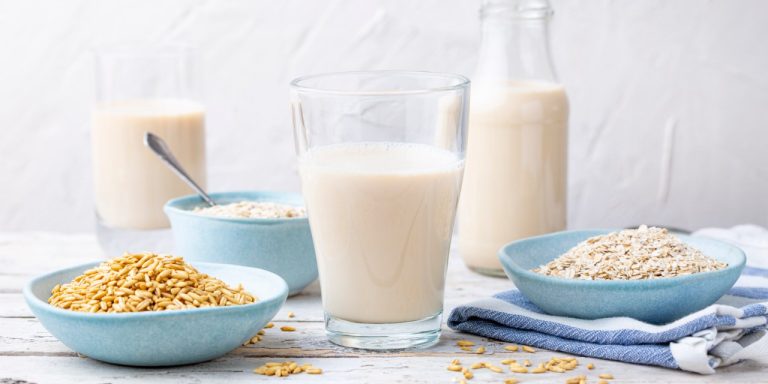
Lactose intolerance: what is it?
Lactose intolerance is associated with an intolerance of milk and dairy products. How does lactose intolerance manifest and how do you test for it? And how long do its symptoms last? Find out more about lactose intolerance.
Definition of lactose intolerance
What is lactose intolerance? In lactose-intolerant people, the enzyme lactase is absent from the small intestine, or not present in sufficient quantities. Lactose intolerance is not the same as a lactose allergy because the immune system is not involved.
Why is the enzyme lactase so important? Lactose is what is referred to as a disaccharide (double sugar), which occurs naturally in the milk of most mammals. This double sugar consists of one part glucose (grape sugar) and one part galactose (mucous sugar). For the disaccharide to be absorbed into the blood from food, it must be split into a monosaccharide in the gut using the enzyme lactase.
In lactose-intolerant people, the majority of the lactose they eat reaches the large intestine undigested, where it is fermented by the bacteria living there. This may result in various different symptoms.
Lactose intolerance: what causes it?
People with a lactose allergy have insufficient levels of the enzyme lactase in their small intestine. The production of this enzyme may be reduced due to genetic reasons or a bowel disease such as coeliac disease.
What are the symptoms of lactose intolerance?
Each individual with lactose intolerance reacts differently. The nature and the intensity of the symptoms vary from patient to patient. Above all, the residual activity of the lactase remaining in the gut and the quantity of lactose absorbed are pivotal in how symptoms manifest. The symptoms of lactose intolerance may include:
- Flatulence: this symptom is associated with lactose intolerance because gas forms during the fermentation of lactose.
- Stomach ache or stomach cramps: stomach ache is a sign of lactose intolerance. This is also caused by the formation of gas during fermentation.
- Diarrhoea and constipation: gastro-intestinal complaints are additional symptoms of lactose intolerance. Lactic and fatty acids, among other things, are generated during lactose fermentation. These cause additional fluid to reach the gut, resulting in diarrhoea. Constipation is another potential symptom of lactose intolerance. This happens if excess methane is produced during fermentation. The gut and thus the digestive system become sluggish and constipation results.
Lactose intolerance is rarer in babies than it is in young people and adults. If your baby has lactose intolerance, the symptoms are similar to those described above. Another is screaming after feeding, when the first symptoms occur. If a doctor diagnoses your baby with lactose intolerance, it is important to ensure they have sufficient calcium intake. Insufficient calcium intake can adversely impact bone development. Talk to your paediatrician about this; they will tell you what you can do.
Lactose intolerance: how long until the symptoms disappear?
How long the symptoms of lactose intolerance last can vary. Generally speaking, the first symptoms do not occur until at least half an hour after consuming food containing lactose. They reach their peak after around 1.5 to 2 hours. But symptoms can persist for longer too.
For many of those affected, limiting their intake of lactose is enough: cutting lactose out entirely is rarely necessary. If you suffer from digestive issues and these do not improve despite a low-lactose or lactose-free diet, talk to your GP.
How do you test for lactose intolerance?
Breath tests like the hydrogen breath test (H2 breath test) are commonly used to diagnose lactose intolerance. This involves the patient drinking a solution containing lactose. The test then measures the amount of hydrogen in the breath. An increased hydrogen content suggests insufficient digestion of lactose since undigested lactose is converted into hydrogen gas by bacteria in the gut. These lactose intolerance tests are available from pharmacies.
You can also test your tolerance to lactose with a blood sugar level test. In this lactose intolerance test, the first thing your doctor will measure is your blood sugar levels. After you have drunk the lactose solution, your blood sugar level is measured again. If you are lactose-intolerant, your blood sugar level will remain the same because your body cannot convert the lactose into glucose.
If you think that you might be lactose intolerant, you can also cut out foods containing lactose for a few days. Your symptoms should ease quickly and significantly during this time. Then, find out how much lactose you can cope with. Gradually reintroduce individual foods until you get a feel for the amount you personally can tolerate. If you find that difficult to do, you can seek support from a dietitian or nutritionist. Find qualified professionals using our search complementary therapists feature.
Lactose intolerance: what foods should I avoid?
There are certain foods that you should avoid if you are lactose-intolerant. Foods you should avoid or restrict are those containing lactose such a milk and dairy products. The lactose content of various dairy products varies depending on the production method used.
Note that lactose can also be found in other products: for instance, baked goods, tinned fish and vegetables, ready meals or sausages. This is because products containing lactose are often used to manufacture them. Read the list of ingredients on the product.
Ingredients: wheat flour, sugar, butter, eggs, skimmed milk powder, salt, raising agent
Can you guess which of these ingredients contains lactose? The list indicates that skimmed milk powder was used in the production process. However, there is no requirement to state the exact amount. Only the position on the list gives an indication. That’s because ingredients are listed in descending order of quantity.
Lactose intolerance: what kind of diet should I follow?
If you are affected by lactose intolerance, you should change your diet to cut out foodstuffs containing lactose wherever possible. This table shows which foods you can incorporate into your diet if you are lactose-intolerant:
|
|
|
|
|---|---|---|
|
|
|
|
|
|
|
|
|
|
|
|
|
|
|
|
|
|
|
|
|
|
|
|
|
|
|
|
Dairy products
Lactose level/tolerance
Alternative
Milk, buttermilk, whey
Contain a relatively high lactose content and are poorly tolerated by most of those affected.
Lactose-free milk
Cream (whipped cream)
Cream contains lactose, but is normally only consumed in small quantities, so is tolerated well.
Lactose-free cream
Yoghurt, sour milk
The lactose is already partially broken down and, as such, better tolerated than milk. It’s worth trying.
Lactose-free yoghurt
Quark, fromage blanc, cottage cheese, ricotta, feta, mozzarella
Moderate lactose content, test tolerance.
Lactose-free/low-lactose cream cheese
Soft cheese (Tomme, Brie) and semi-hard cheese (Appenzeller, Tilsiter, Raclette)
Only contain traces of lactose and are tolerated well.
No alternative necessary
Hard cheese (Emmentaler, Gruyère) and extra hard cheese (Sbrinz, Parmesan)
Are lactose-free and tolerated well.
No alternative necessary
Butter
Butter is practically lactose-free.
No alternative necessary
Source: Swiss Association for Nutrition (SGE)
Lactose-free recipes
In the Helsana Coach app, you can find lactose-free recipes including information on ingredients, preparation and nutritional values. These can help you to maintain a balanced diet. Download the Helsana Coach app now.
Avoiding lactose in general?
If you eat dairy products and don’t suffer any symptoms, you are not lactose-intolerant. Cutting out lactose across the board is not necessary. On the contrary: you will limit your diet unnecessarily and reduce the options available to you.
Lactose-free specialist products and enzyme tablets
Shops now stock a wide range of lactose-free specialist products. The lactose is broken down at the production stage. It then takes the form of glucose or galactose that can be absorbed immediately in the gut.
Enzyme preparations in tablet form are also available. For instance, sufferers can take the tablets shortly before eating a meal containing lactose. The lactase contained in the tablet breaks down the lactose contained in the food.
If you think you might have lactose intolerance, talk to your doctor. You can also refer to a dietitian to obtain further support. Eating a varied and balanced diet is possible – even if you’re lactose-intolerant.

The expert in this field provided the editorial team with advice and input for this article. Eliane Wyss (medical assistant and nutrition coach) works in the Helsana health consultation service. She supports customers on questions to do with nutrition and other health topics.


Newsletter
Find out more about current health issues every month and get all the information you need about our attractive offers from all Helsana Group companies * delivered by e-mail to read whenever it suits you. Our newsletter is free of charge and you can sign up here:
We did not receive your information. Please try again later.
* The Helsana Group comprises Helsana Insurance Company Ltd, Helsana Supplementary Insurances Ltd and Helsana Accidents Ltd.
